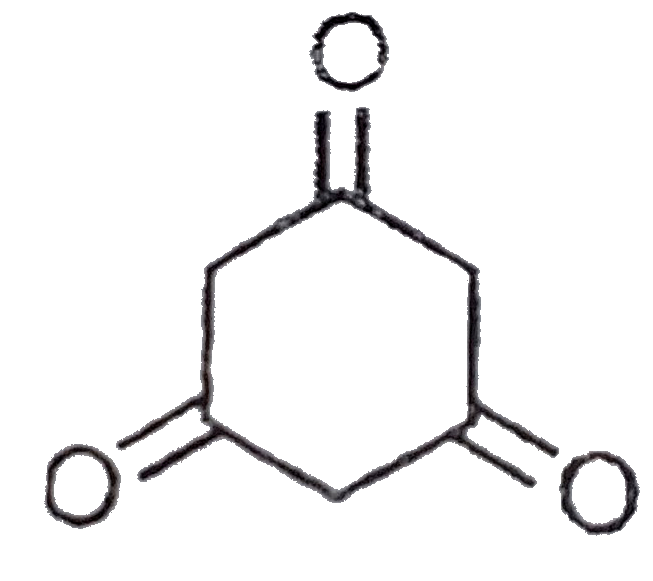In following reaction what are P, Q, R and S.
C6H5N+2Cl−H2O−−→ΔP(CH3CO)2O−−−−−−−→NaOHPAn.AlCl3−−−−−→R Zn Powder −−−−−−−→ΔS Solution in Gujrati
P - Aniline, Q - Acetanilide, R - P - amino acetophenone, S - Benzene
P - Phenol, Q - Phenyl acetate, R - 2-Hydroxy acetophenone, S - Acetophenone
P - Phenol, Q - Acetophenone, R - 2-Hydroxy acetophenone, S - Benzene
P - Phenol, Q - P-methyl acetophenone, R - 2-Hydroxy acetophenone, S - Acetophenone
The correct Answer is:B
Step by step video, text & image solution for In following reaction what are P, Q, R and S. C_(6)H_(5)N_(2)^(+)Cl^(-)overset(H_(2)O)underset(Delta)rarr P overset((CH_(3)CO)_(2)O)underset(NaOH)rarr P overset(An.AlCl_(3))rarr R overset(" Zn Powder ")underset(Delta)rarr S by Chemistry experts to help you in doubts & scoring excellent marks in Class 12 exams.
Topper's Solved these Questions
- BOOK - KUMAR PRAKASHANCHAPTER - HALOALKANES AND HALOARENESEXERCISE - SECTION - D NCERT EXEMPLAR SOLUTION (Long Answer Type Questions)3videos
HALOALKANES AND HALOARENES
- BOOK - KUMAR PRAKASHANCHAPTER - GENERAL PRINCIPLES AND PROCESSES OF ISOLATION OF ELEMENTSEXERCISE - SECTION - E (MCQs ASKED IN GUJET/BOARD EXAMS)46videos
GENERAL PRINCIPLES AND PROCESSES OF ISOLATION OF ELEMENTS
- BOOK - KUMAR PRAKASHANCHAPTER - POLYMERSEXERCISE - SECTION - E (MCQs asked in Board Exams)51videos
POLYMERS
Similar Questions
Some alkyl halides undergo substitution whereas some undergo elimination reaction on treatment with bases. Discuss the structural features of alkyl halides with the help of examples which are responsible for this difference.
View SolutionDuring electrolysis of aqueous solution of Na2SO4 using graphite electrode .........
02:26View SolutionWhich polymer is used in preparation of capsules ?
02:47View SolutionComplete the following: a. b. c. d. e. f. g. h. PhCHO + Cl_(2) overset("No catalyst")rarr(A) i. j. PhCHO+(C_(2)H_(5)CO)_(2)O overset(C_(2)H_(5)COONa)rarr A k. l. m. n. o. p. q. r. s. PhCOCH_(3)+SeO_(2)rarr (A) t. PhCH=CH-overset(O)overset(||)C-Ph+KCN overset(CH_(3)COOH)rarr (A) u. Ph-underset(CN)underset(|)CH-overset(O)overset(||)C-CH_(3) overset((i)H_(3)O^(o+))underset((ii)Delta)rarr (A) v. w. Ph-overset(OH)overset(|)underset(Ph)underset(|)C-CH_(2)NH_(2) overset(HNO_(2))rarr (A) overset("Oxidation")rarr (B) x. PhCOPh+KOH rarr (A)+(B) y. z.
01:53View SolutionIn the given reaction sequence C6H5−CH2−NH2CHCl3/Alc.KOH−−−−−−−−−−−→Δ[X]H2O/NaOH−−−−−−−→[Y],[Y] will be:
View SolutionCH_(3)CH_(2)Br overset(AgCN)rarr A overset(NaOH, Delta)underset(overset(o+)(H_(3)O))rarrB,(B) is:
View SolutionCH_(3)-(CH_(2))_(3)-OH overset(CH_(3)-underset(O)underset(||)overset(O)overset(||)(S)-Cl)underset(ET_(3)N)(rarr)(A) overset(14)overset(KCN)(rarr)(B) overset(H_(3)O^(o+))(rarr)(C) Product (C) is :
View SolutionThe acid S obtained through the following sequence of reactions is : C_(2)H_(5)Br overset(Alc. KOH)rarr P underset(C Cl_(4))overset(Br_(2))rarr Q underset(("excess"))overset(KCN)rarr R overset(H_(3)O^(+))rarr S
View SolutionIdentify the product S in the following series of operations : C_(2)H_(2) underset(Hg^(2+))overset(dil. H_(2)SO_(4))rarr (P) overset(K_(2) Cr_(2) O_(7) // H^(+))rarr (Q) overset(CaCO_(3))rarr (R) overset(Delta) rarr (S)
View Solution(i) P(hydrocarbon)O3/Zn−−−→H2O ,
 , +CH2=O , (ii) Q(C6H10)O3/Zn−−−→H2O Hexane- 1,6-dial Write the structure of P and Q.View Solution
, +CH2=O , (ii) Q(C6H10)O3/Zn−−−→H2O Hexane- 1,6-dial Write the structure of P and Q.View SolutionComplete the following sequence of reactions : underset(Delta)overset(P_(2)O_(5))rarr(A)overset(H_(3)O^(+))rarr(B)overset(Br_(2)//P)rarr(C)overset(AgOH)rarr(D)underset(-2H_(2)O)overset(Delta)rarr"Diester" .
03:05View SolutionIn the reaction
CH3CN+2HHCl−−→etherXH2O−−→ΔY, Y isView SolutionIn the reaction sequence CH_(3)-overset(O)overset(||)(C)-H-underset(.^(Θ)OH)overset(HCN)rarr(A) underset(Delta)overset(H_(2)O //overset(o+)(H))rarr Product is/are :
02:40View SolutionComplete the following reaction: underset((A))(o-HOOC) - C_(6) H_(4) - CH_(2) - Ph overset(SOCl_(2))rarr (B) underset(AlCl_(3))overset("Anhyd")(rarr) (C) underset(+HCl)overset(Zn + Hg)(rarr) (D) underset(600^(@)C)overset(S "or" Se)(rarr) (E)
02:27View Solutionनिम्न अभिक्रियाओं में A, B तथा C की संरचना दीजिए -
(i) CH3CH2INaCN−−−→A¯¯¯O−−−−−−−−−−→ आंशिक जलयोजित BNaOH+Br2−−−−−−−→C
(ii) C6H5N2ClCuCN−−−→AH2O/H+−−−−−→BNH3−−→ΔC
(iii) CH3CH2BrKCN−−→ALiAlH4−−−→BHNO2−−−→0∘CC
(iv)C6H5NO2Fe/HCl−−−−→ANaNO2+HCl−−−−−−−−→273KBH2O/H+−−−−−→ΔC
(v)CH3COOHNH3−−→ΔANaOBr−−−→BNaNO2/HCl−−−−−−−→C
(vi) C6H5NO2Fe/HCl−−−−→AHNO2−−−→273KBC6H5OH−−−−→C.02:12View Solution

